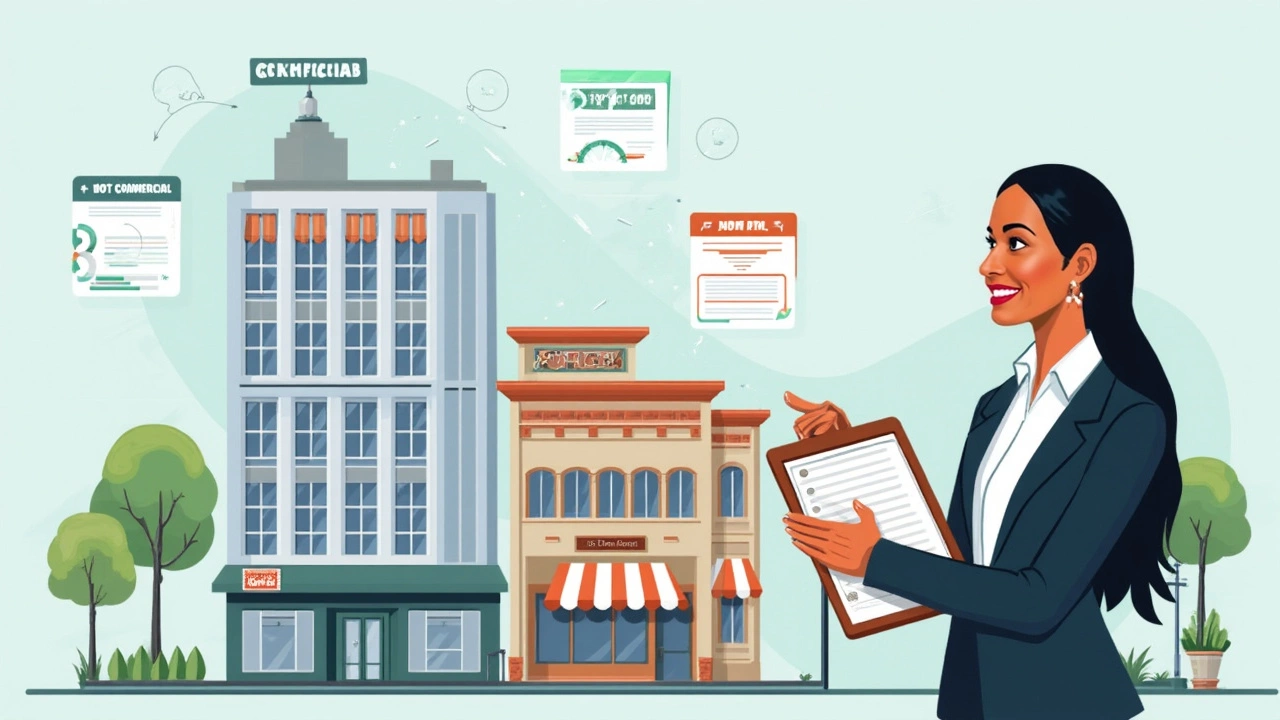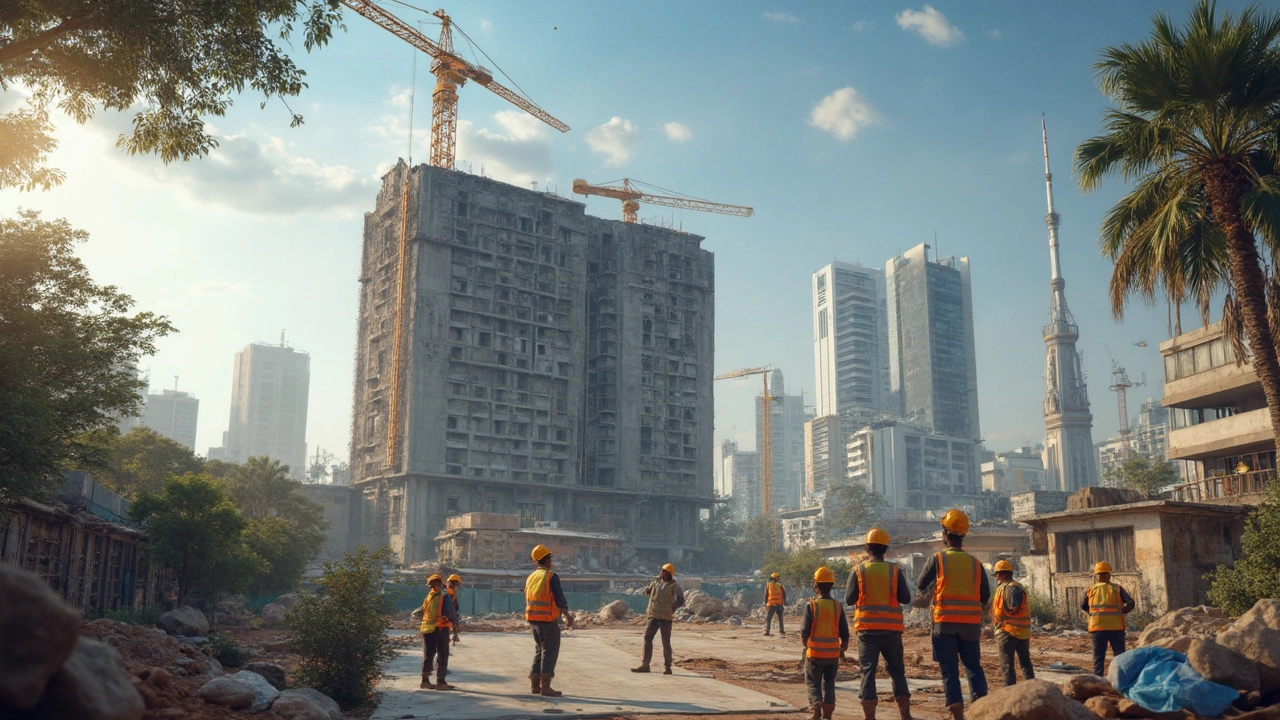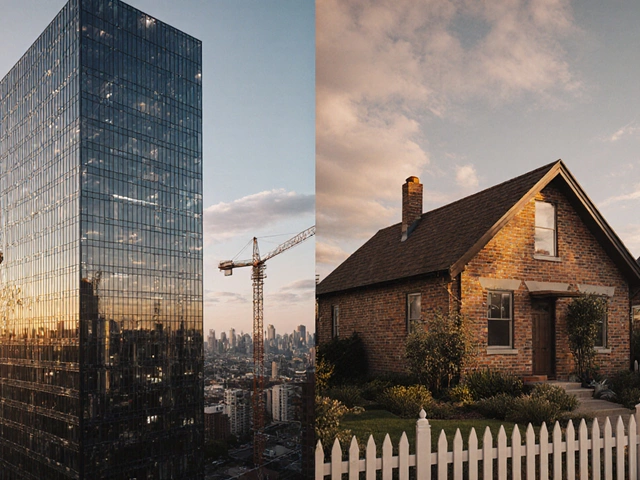Most people think 'commercial' means anything with a business vibe—an office, a shop, maybe a big warehouse. But if you look up the federal definition, it gets more specific than that. At the core, 'commercial' refers to property or buildings used mainly for business purposes, not for living in. So, you’re talking places like stores, hotels, office buildings, and even some apartment complexes, depending on size and zoning.
Here’s why that matters: building something that gets classified as 'commercial' isn’t just a label. It sets off a whole different set of rules—building codes, ADA requirements, fire safety, and a ton of paperwork. Mess this up, and you’re facing fines, denied permits, or worse, the dreaded construction stop-work order. Knowing the exact federal definition saves you from these headaches and helps you plan better, especially if your project might blur the line between business and residential use.
- The Federal Definition in Plain English
- Why This Matters for Construction Projects
- Real-World Examples (and Misconceptions)
- Tips for Navigating Regulations
The Federal Definition in Plain English
When it comes to construction, the feds have a pretty tight idea of what 'commercial' means. In simple terms, a commercial building is any structure used for the actual running of a business or the selling of goods and services. This covers everything from a corner grocery store to huge office towers. But there’s more to it than just having people come and go to buy stuff.
The main government agencies, like the U.S. Census Bureau and the Internal Revenue Service (IRS), line up with a standard: commercial buildings are designed for non-residential use, mainly for business, commerce, or trade. In government code books, you’ll often spot language like “used for the conduct of business” or “housing commercial activities.” Basically, if the main job of a building is to make money—not house people—it checks the commercial box.
Here’s a straightforward comparison:
| Type | Main Use | Examples |
|---|---|---|
| Commercial | Business or Trade | Retail stores, offices, hotels, warehouses |
| Residential | Living Space | Houses, apartments, dorms |
| Industrial | Manufacturing/Production | Factories, plants, refineries |
Don’t get tripped up by mixed-use properties. If it’s an apartment building but the ground floor is packed with shops or restaurants, the government might treat parts of it as commercial construction. The split matters for codes, insurance, even taxes.
And here’s something a lot of folks miss: federal rules aren’t the only show in town. State and city codes can turn the definition on its head. The trick is to check all layers—federal, state, and local—before you start drawing up blueprints or pulling permits.
Some key triggers that land you in the “commercial” zone:
- Open to the public during regular hours
- Employees work on site (not just owners)
- Main use is commerce, like selling, leasing, or providing services
- Special safety, accessibility, or energy rules kick in
Not every building people call 'commercial' fits the federal bill, so always double-check if your project actually qualifies. A little homework here will save you a headache—and maybe a stack of legal fees—down the road.
Why This Matters for Construction Projects
Getting the definition of commercial construction right is more than just paperwork. It actually shapes how you design, budget, and build your project from day one. If your project is commercial by federal standards, the rules ramp up right away. You’ll need to follow stricter building codes, set up accessibility for people with disabilities, and often work with extra safety systems like sprinklers, fire alarms, and clear emergency exits.
Here’s something a lot of new builders overlook: commercial projects almost always have to go through a more complicated permit and inspection process. It’s not just about getting a rubber stamp; inspectors check for things like ADA compliance, proper load-bearing walls, and even energy efficiency. Skipping a step means real delays—sometimes months, not just days or weeks.
To see just how different the process can be, check out this comparison:
| Requirement | Commercial Project | Residential Project |
|---|---|---|
| Permit Complexity | High | Moderate |
| ADA Compliance | Mandatory | Not Required |
| Fire Safety Systems | Sprinklers, alarms, marked exits | Basic smoke alarms |
| Energy Codes | Strictly enforced | Less strict |
| Inspections | Multiple (site, fire, health) | Basic building |
One thing to really watch for: mixed-use properties. Say you plan a building with shops on the first floor and apartments above. Federal and local officials might treat the lower floor as commercial and the upper as residential, and you have to meet the codes for both. This gets expensive if you’re not ready for it.
There’s also the issue of insurance and liability. Commercial rules can drive up your insurance premiums, but only if your property is classified correctly. If something goes wrong and you guessed wrong on the type, you might not be covered. That’s a nightmare you just don’t want.
So, if you’re planning any build that smells like business, always check the federal—and local—definition of commercial upfront. It’s a small step that saves you time, money, and a mountain of headaches later.

Real-World Examples (and Misconceptions)
Let’s clear up a few things right away: not every building with people working in it counts as "commercial" under the federal definition. For instance, a small home office inside your house? That’s still residential, not commercial, even if you’re running a business there. The lines blur fast, though, when you talk about things like mixed-use buildings or big apartment complexes.
Here are some real-world scenarios to make the difference super clear:
- Commercial construction projects include obvious stuff like malls, restaurants, offices, and shopping plazas. These are designed with public access and business in mind.
- What about apartment buildings? If it’s a simple duplex or quadplex, most federal rules still call this residential. But if it’s a huge complex with more than four units or regular on-site services, you may need to follow commercial codes.
- Buildings like hotels and motels are always commercial, because they’re not permanent homes and they serve the general public.
- Warehouses or distribution centers? These count as commercial, unless they’re just for personal use.
- If you have a mixed-use property—say, a corner store with apartments upstairs—things get trickier. Usually, the commercial part must follow business codes, while the residential part sticks to home safety rules.
One big misconception: a property’s commercial tax status doesn’t automatically mean it follows commercial construction codes. Zoning and use rights set by city or county officials can differ from how the IRS or another federal agency sees the building.
Eric Anderson, an inspector who’s worked on both residential and business sites, puts it well:
“Just because you sell something out of your building doesn’t mean it’s commercial in the eyes of the code. It’s all about intended use, design, and who’s walking through the door.”
If you’re starting a remodel or new build, ask your local building department which rules apply. The feds set the baseline, but local officials will spell out what really counts in your neighborhood.
Tips for Navigating Regulations
Getting your project classified as commercial construction opens up a box of rules—some federal, some local. Here’s what you should focus on to avoid nasty surprises during planning or after you’ve started work.
First thing: check with your local building department. Even if the federal government sets the broad definition, cities and counties often drill down further. What passes as an 'office' in federal terms might be classified differently by your municipality. This matters because local codes often layer on top of federal standards when it comes to permits, fire exits, signage, and even bathroom numbers.
- Get clear on zoning and land use maps: Almost every town posts their zoning maps and regulations online. Look them up, or walk into the office and ask for details about your specific address.
- Understand ADA requirements: Commercial buildings must meet strict federal accessibility rules. Think ramps, door widths, bathrooms with grab bars—the whole deal. Missing these will blow back on you with extra costs and possible lawsuits.
- Cross-check your use: Some buildings work for more than one use—like an apartment building with ground-floor shops. These mixed-use projects might need to follow both residential and commercial regulations at the same time. Don’t assume; ask specifically about your setup.
- Don’t wing the paperwork: On commercial projects, you’ll need more than the basic permit. Expect a chunkier packet: environmental impact reports, fire safety plans, ADA compliance docs, and maybe even a traffic study, depending on size.
A good tip: keep all your communication and approvals in writing. Building departments change people, and verbal agreements don’t mean much when a new inspector shows up. And before you even buy land, call or email the code office to check if your planned use is allowed. It’s better to hear 'no' early than after you’ve spent money.
For renovations or upgrades, check if older buildings are ‘grandfathered’ under old rules. But don’t bank on it. Once you change enough of the space, most places will make you bring everything up to code.






